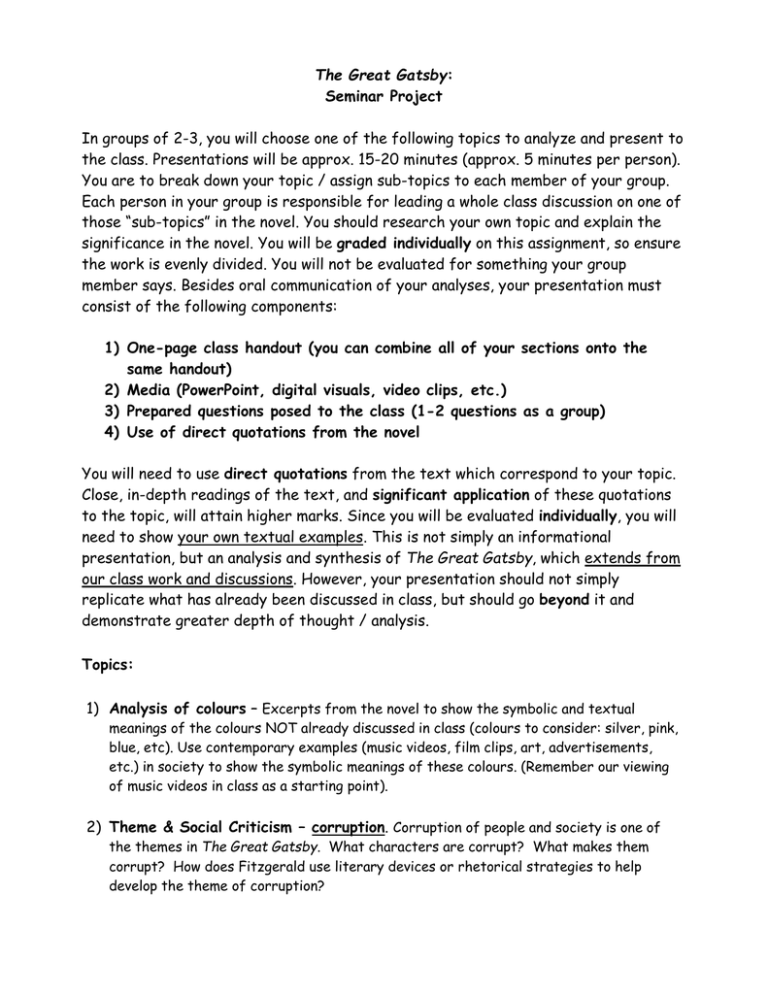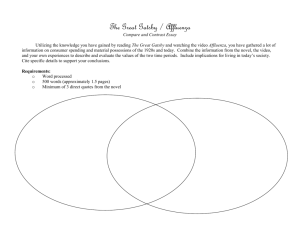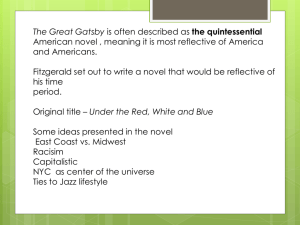ENG3U Great Gatsby Project
advertisement

The Great Gatsby: Seminar Project In groups of 2-3, you will choose one of the following topics to analyze and present to the class. Presentations will be approx. 15-20 minutes (approx. 5 minutes per person). You are to break down your topic / assign sub-topics to each member of your group. Each person in your group is responsible for leading a whole class discussion on one of those “sub-topics” in the novel. You should research your own topic and explain the significance in the novel. You will be graded individually on this assignment, so ensure the work is evenly divided. You will not be evaluated for something your group member says. Besides oral communication of your analyses, your presentation must consist of the following components: 1) One-page class handout (you can combine all of your sections onto the same handout) 2) Media (PowerPoint, digital visuals, video clips, etc.) 3) Prepared questions posed to the class (1-2 questions as a group) 4) Use of direct quotations from the novel You will need to use direct quotations from the text which correspond to your topic. Close, in-depth readings of the text, and significant application of these quotations to the topic, will attain higher marks. Since you will be evaluated individually, you will need to show your own textual examples. This is not simply an informational presentation, but an analysis and synthesis of The Great Gatsby, which extends from our class work and discussions. However, your presentation should not simply replicate what has already been discussed in class, but should go beyond it and demonstrate greater depth of thought / analysis. Topics: 1) Analysis of colours – Excerpts from the novel to show the symbolic and textual meanings of the colours NOT already discussed in class (colours to consider: silver, pink, blue, etc). Use contemporary examples (music videos, film clips, art, advertisements, etc.) in society to show the symbolic meanings of these colours. (Remember our viewing of music videos in class as a starting point). 2) Theme & Social Criticism – corruption. Corruption of people and society is one of the themes in The Great Gatsby. What characters are corrupt? What makes them corrupt? How does Fitzgerald use literary devices or rhetorical strategies to help develop the theme of corruption? 3) Theme & Social Criticism – idealism. Analyze the way the theme is explored, what is being communicated by the author through this theme, and contextualize the modern relevance. 4) Theme & Social Criticism – truth & illusion. Analyze the way the theme is explored, what is being communicated by the author through this theme, and contextualize the modern relevance. 5) Theme & Social Criticism – carelessness. Analyze the way the theme is explored, what is being communicated by the author through this theme, and contextualize the modern relevance. 6) Theme & Social Criticism – hope and defeat. Analyze the way the theme is explored, what is being communicated by the author through this theme, and contextualize the modern relevance. 7) Tragic Hero – Research Aristotle’s theory of the tragic hero to analyze Gatsby as a tragic hero. Each member will take 2 different points from Aristotle’s theory, and directly apply these to the character of Gatsby, referencing specific character moments from the novel. Each group member will also analyze a tragic hero from another film or another piece of literature (which we haven’t already discussed as a class). 8) The American Dream - Explain how the American Dream is treated in the novel. How does Fitzgerald’s use of symbolism help to develop the theme of the collapse of the "American Dream"? According to Fitzgerald, why is the American Dream tainted? Does the American Dream have any potential for good? If so, why does it go wrong? If not, why can it never bring true happiness? 9) Nick’s narration – reflections and self-reflections. Who is he? By chapter 8 he seems to relay Gatsby’s history as if he experienced it himself. Does he evolve as a character? Has he changed from the beginning to the end of the novel? How is he different from the other characters? Is he honest? Is he a reliable narrator? 10) Analysis of symbols – the weather / seasons. Analyze the weather as it is depicted in the novel. Explain the progression of weather. How does the change in season reflect plot or emphasize character emotions? Excerpts from the novel to show the symbolic and textual meanings of this symbol. Each group member must relate this textual evidence to these symbols outside of the text (from current culture, other literature, film, etc.) 11) Analysis of symbols – geography. Analyze what each location means in the novel: The Valley of Ashes, New York City, East Egg, West Egg, and Minnesota (“the west”). How does each location highlight character traits, moral codes, or decay? What is the difference conveyed about the East vs. the West? City vs. countryside? Excerpts from the novel to show the symbolic and textual meanings of this symbol. Each group member must relate this textual evidence to these symbols outside of the text (from current culture, other literature, film, etc. 12) Analysis of symbols – plot elements: The Quest for the Holy Grail. What is the original meaning of this quest? Where does the idea originate? Other stories where it is used? Excerpts from the novel to show the symbolic and textual meanings of this symbol. Each group member must relate this textual evidence to these symbols outside of the text (from current culture, other literature, film, etc.) 13) Analysis of symbols – character names. Excerpts from the novel to show the symbolic and textual meanings of this symbol. What does each character name symbolize? How does it reflect or illuminate character traits? Each group member must relate this textual evidence to these symbols outside of the text (from current culture, other literature, film, etc.) 14) Deconstruction of Fitzgerald’s writing style – use of sensory images, figurative language, heightened vocabulary, long, wordy sentences, irony, motifs, diction, point of view, etc. Explain and analyze his writing style, AND each group member will also create a paragraph imitating Fitzgerald’s style on topics of your choosing (which you will also read to the class). (Ex. Nick experiencing the menacing anticipation of going home at 2:50 from his mundane, abysmal English class ) 15) Literary Genres & Styles – Research the following critical terms / literary eras: Modernism, Realism, and Romanticism. Define the common traits of each. How do the stylistic elements of each of these periods come out in the novel? Why are they used? 16) Role of Women – Daisy, Myrtle, Jordan. Qualities, characteristics, stereotypes, redeeming actions? How do they lead to the downfall of the hero, or themselves and/or other characters? 17) Analysis of love – There are a range of relationships in the novel that convey the morals and social norms of Fitzgerald’s era. How is love defined in the novel? How do different characters view love? What are the different types of love (Consider the following types of love: puppy love, romance, obsession, crush, courtly love, affair, emotional intimacy, friends, stalker, unrequited love). As a teenager, have you seen these various types of love play out in your world? What is being said about love by Fitzgerald through various character actions? Research what is meant by the term “courtly love.” How does Gatsby fit the mould of a “courtly lover”? 18) Setting: The 1920s – Use references from the text that relate to 1920s history in terms of organized crime, fashion, the role of women, music, etc. You may want to use video clips and images in a slide show or video montage. What message is being communicated by Fitzgerald by so many cultural references? Jazz Age values? The “roaring” 20s? 19) The Portrayal of Race - The portrayal of race and religion are points of interest in The Great Gatsby. How and when do characters convey their opinions about these issues? Who does? Why? How is it relevant to the plot? How are African Americans, Jews, and Catholics represented by the words and actions of Fitzgerald’s characters? Consider why Fitzgerald may have chosen to depict these groups in the manner in which he did. As always, be able to use specific examples from the novel to support your opinions and conclusions. 20) The depiction of “Greatness” - In what sense is Gatsby “great”? Pay particular attention to Nick’s portrayal of Jay Gatsby, his past, his words, and his actions. How does Nick vacillate between admiration and disapproval of Jay Gatsby? What are we to make of Nick’s comment that Gatsby “represented everything for which [Nick has] an unaffected scorn”? What does Nick mean when he proclaims that there is “something gorgeous” about Gatsby? What does Nick mean when he states that “Gatsby turned out all right at the end”? What do characters in the novel dream of? What is being said about unattainable dreams? How do characters become “lost” in this attempt to discover “greatness”? Analyze this notion of “greatness” and how it leads to the destruction of the hero and/or spreads suffering to others. 21) Modern Relevance – what does the novel say about wealth, class, power, relationships, success, crime, consequence? Show how it connects to our modern world by providing specific examples from our culture and time. 22) Direct and indirect characterization - Show how Fitzgerald constructs his characters. Each group member will choose 2 characters to analyze and deconstruct with related quotations. In your analysis, relate each character to a celebrity, past or present, to emphasize his/her main characteristics. This part should not form your entire character analysis, but stem from it, using the celebrity as modern day context. What values does this celebrity exude to the public? What accounts for our fascination with the rich and famous? What does this tell us about the modern values of society? Point out significant connections to the values demonstrated by the main characters in the novel. (NOTE: I DO NOT want to see artificial connections being made, like how Gatsby is like Justin Bieber or how Tom Buchanan is like Chris Brown or how Daisy is like Taylor Swift. These are superficial comparisons at best and will not earn you a decent grade. This topic will require some deep critical thinking, drawing upon sophisticated analysis…consider socio-economic similarities, race, age, class, etc. when determining your celebrity connection, and not something superficial like how Chris Brown treats women horribly like Tom or how Taylor Swift dates a lot of men, similar to how Daisy cheats on Tom, etc.).




